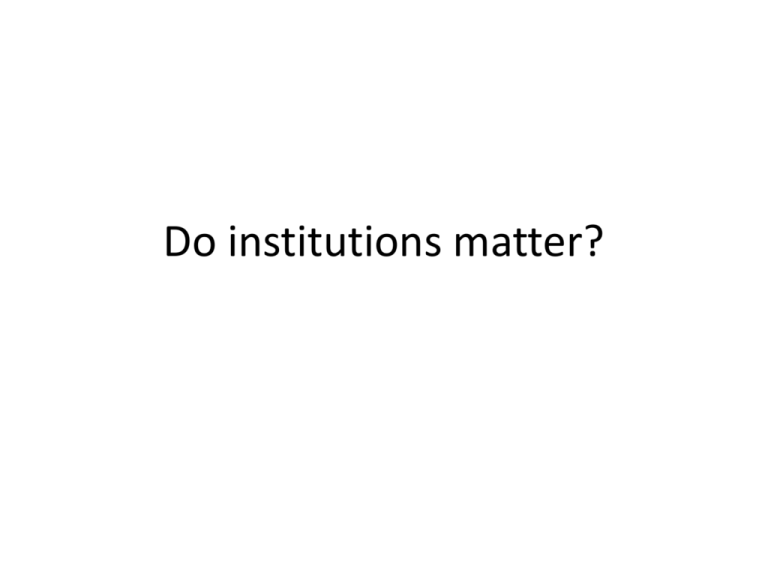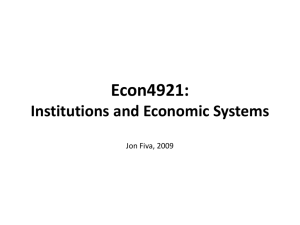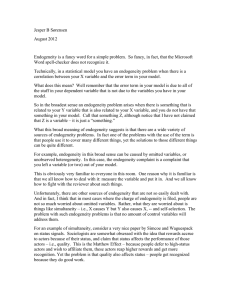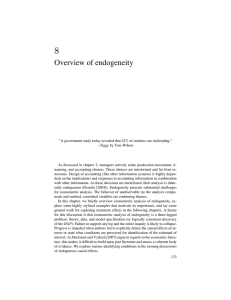Does institutions matter?
advertisement

Do institutions matter? Institutions defined (again) • Douglas North: ”Institutions are the humanly devised constraints that structure human interaction. They are made up of formal constraints1, informal constraints2 and their enforcement characteristics. Together they define the incentive structure of societies and specificially economies”. – 1) rules, laws, constitutions – 2) norms, behavior, conventions • … or simply ’the rules of the game’ Institutions defined (again) cont. • Can also be useful to distinguish between: – Economic institutions (individual property rights, contracts that can be written and enforced, patent laws etc.) – Political institutions (democracy vs nondemocracy, electoral rules, extent of checks and balances etc.) Correlations • Large literature documenting positive correlations between certain institutions and economic performance. The identification problem • But this hardly demonstrates a causal effect of institutions on economic performance. – The kind of question we are interested in answering is: • • – – – – ”… if the UK were to switch its electoral rule from majoritarian to proportional, how would this affect the size of its welfare state or its budget deficitis?” (PT) ”If Argentina were to abondon its presidential regime in favor of a parliamentary form of government, would this facilitate the adoption of sound policy towards economic development?” (PT). How would changing institutions in Nigeria to those of Chile affect economic performance? (AJR) How would incresing the ’social infrastructure’ of Zaire to that of Switzerland affect productivity? (HJ) How did the introduction of universal suffrage affect redistribution levels in western Europe? (AR) Does inequality cause underdevelopment? (Easterly) • Hard questions to answer empirically • Institutions are endogenous to economic performance. – Causality runs both ways – Omitted variable bias • Fundamental problem: cannot observe the counterfactual The identification problem cont. • Figure from Przeworski04 (’institutions matter?’) The identification problem cont. • What we can learn from correlations and OLS regressions is limited. • Acemoglu (2005) makes this argument forcefully in a review of Persson and Tabellini (2003). Endogeneity • Agents understand that different policies will map into different outcomes – Policy endogeneity – ”If state policy making is purposeful action, responsive to economic and political conditions within the state, then it may be necessary to identify and control for the forces that lead policies to change if one wishes to obtain unbiased estimates of a policy’s incidence” (Besley and Case 2000,EJ) • Agents understand that different institutions will map into different policies and outcomes. – Endogeneity of institutions Endogeneity cont. • Large literature treat institutions as exogenous (e.g. institutions are ’predetermined’ or ’given by history’) • However, the political economy approach suggests that the same factors that make policies unappealing to treat as exogenous is relevant for institutions. – E.g. The introduction of democracy was not ’random’ • Papers that try to deal with this problem includes Mauro (1995), Hall and Jones (1999), Acemoglu, Johnson and Robinson (2001) and Persson and Tabellini (2003) Proximate vs fundamental causes • Vast differences in prosperity across countries – Output per worker 32 times higher in top five countries relative to to bottom five countries (HJ). • What can explain this difference? • 1) Physical capital differences – Poor countries don’t save enough • 2) Human capital differences – Poor countries don’t invest enough in education • 3) ’Technology’ differences – Poor countries don’t invest enough in R&D and technology adaption, and fail to organize production efficiently • 1 – 3 are however proximate causes of differences in prosperity. • What are the fundamental causes? • How do we distinguish between the effects of institution from the conditions that give rise to them? Geography • Jared Diamond – Proximate causes: guns, germs and steel – Fundamental causes: geography • Availability of crops and animals • Axes of communication across continents – Geographical differences have determined the timing and nature of settled agriculture. This have shaped societies ability to develop complex societies. Geography cont. Institutions • Hall and Jones argue: • ”By social infrastrcture we mean the institutions and government policies that provide the incentives for individuals and firms in an economy”. – The incentives can encourage productive or predatory behavior… • Institutions are not exogenous but there are potential sources of exogenous variation in history. – European colonization as a ’natural experiment’. – Use history to estimate the causal effect of institutions on growth. • HJ use Western European influence to solve the endogeneity problem – Distance from equator (latitude), which is correlated with ’western influence’ (good) – The extent of euriopean languages spoken today in these countries. • • These instruments are not entirely convincing (see the disc. In Acemoglu 05JEL). We focus on the work of Acemoglu, Johnson and Robinson. AJR approach rests on three premises 1. Different types of colonization policies created different sets of institutions. • ’Extractive states’ e.g. Congo, Nigeria, Tunisia – – – • No protection of private property No checks and balances against government. Confiscatory taxation Neo-Europes, i.e. US, NZ, AUS. – – Protection of private property Law and order 2. Feasibility of settlements affected the probability of different sets of institutions. – Do not argue that Eur. Influence in itself was positive or negative 3. Early institutions affect current institutions AJR approach rests on three premises Settler mortality • In the tropics, 80 percent of European deaths were caused by malaria and yellow fever. – Europeans in Africa, India and Caribbean faced very high death rates. – But death rates for the adult local population were much lower (developed immunity). – Yellow fever in W. Africa was ’a strangers disease’. – … and had little effect on the health and economy of indigenous people. • Many of the areas that were colonized in the tropical zone were richer and more densely populated in 1500 than the temperate areas later settled by Europeans. Current institutions • Protection from expropriation risks. – Vary from 0 to 10, for each country for each year. – AJR use average over 1985-1995 – Extractive state low value on this index. • Broad measure of property rights. • Data from Political Risk Services – Private company which assess the risk that foreign investment will be expropriated in different countiries. The equation of interest OLS • • Plain OLS estimates of eq (1) find a strong assocation between R and Y. Also when controlling for latitude and continent dummies. Why doesn’t this necessarily show a causal effect? 1. Rich economies may prefer (or afford) better institutions (the causality runs the other way) 2. Omitted variables 3. Measure of institutions created ex post 4. Attenuation bias (due to poor institution measure) • Does this suggest an upward or downward bias in OLS? IV • Solution, treat R as an endogenous variable. • The first stage: • What is the identifying assumption? IV cont. • IV estimates suggest a large and statistically significant effect of institution on economic performance. – Differences in institutions account for over 75% of the variation in income per capita today – Improving the institutions of Nigeria to the level of Chile would lead to a 7-fold increase in Nigeria’s income. • (in practice the difference is 11-fold) – No impact of geography, when institutions are treated as an endogenous variable • ”These results suggest that Africa is poorer than the rest of the world not because of pure geographic or cultural factors, but because of worse institutions” (p. 1372 AJR). IV cont. • Results robust to: – Different subsamples – Controlling for continent dummies, geography. – Controlling for current prevalence of malaria and life expectancy – Only using yellow fever as an instrument (eradicated today) Conditions in the colonies • A key aspect of AJR is that it is not the identity of the colonizer that matters, but conditions in the colonies. – Clearly depart from HJ where European influence in itself is deemed beneficial • Related to the work of Engerman and Sokolof (1997). – The Caribbean islands illustrate the adverse affects of Europeans, which set up repressive regimes based on slavery and forced labor. – Factor endowments such as geography, climate and soil conditions help explain the builings up of ’good institutions’ in nortern am. And ’poor institutions’ in Lat. Am. From ES 2000 JEP • North am. Of relatively ”marginal econ. Interest compared with the extraordinary opportunities available in the Caribbean and Lat. am” (ES2000) • Haiti probably richest country in the world (on per cap basis) in 1790 Why did US/CAN experience sustained econ. Growth in 18th and early 19th century? (while others did not attain this goal until late 19th or 20th century, if ever…) • • Factor endowments • Some econ. Historians have explained the divergence due to the identity of the colonizer. – But striking differences within the identity of the colonizer (e.g. US, Can vs. Barbados, Jamaica, e.g. Argentina vs Peru) calls for other explanation. • AJR explain the divergence as a result of institutions. • ES: Factor endowments (incl. Climate, soil, density of native population) – Predisposed North am. Colonies towards relatively equal distributions and corresponding institutions favoring a broad range of the population in commercial activity. – Predisposed Lat. Am, Caribbean colonies to highly unequeal distributions and institutions that protected the elite. • The suitability for cultivating sugar and other highly valued commodities economics of scale extensive use of slaves, and the densely populated native population. Persistence • ”In those societies that began with extreme inequality, elites were better able to establish a legal framework that insured them disproportionate shares of political power, and to use that greater influence to establish rules, laws, and other government policies that advantaged members of the elite relative to non-members – contributing to persistence over time of the high degree of inequality”.(ES2000) Inequality and per capita income • A recent paper by Easterly (JDE 2007) draws on ES to try to answer the question: does inequality cause underdevelopment? Inequality and per capita income • Measures of factor endowments as instruments for ’structural inequality’. Sugarcane labor intensive high historical ineq. Wheat capital intensive low historical ineq. • What is the identifying assumption? • Do we believe in this? Links • • • • • • • • Acemoglu's review essay of PT: http://www.atypon-link.com/doi/abs/10.1257/002205105775362069 P&T's book: http://mitpress.mit.edu/catalog/item/default.asp?ttype=2&tid=9930 Besley and Case00: http://www.blackwell-synergy.com/doi/pdf/10.1111/1468-0297.00578 Przeworski04: http://as.nyu.edu/docs/IO/2800/go_2004.pdf Easterly07: http://www.sciencedirect.com/science?_ob=ArticleURL&_udi=B6VBV-4MNYK141&_user=674998&_coverDate=11%2F30%2F2007&_rdoc=1&_fmt=&_orig=search&_sort=d&view=c&_acct=C000036598&_ version=1&_urlVersion=0&_userid=674998&md5=e1a5dabc9db3b764417f8e77069338d8 Jared Diamonds book 'Guns, germs and steel‘: http://www.amazon.com/Guns-Germs-Steel-FatesSocieties/dp/0393317552 Engerman and Sokoloff 2000: http://www.jstor.org/view/08953309/di014723/01p02397/0 Links to Hall and Jones, Acemoglu, Johnson and Robinson, Mauro, Engerman and Sokoloff97 are on the reading list









